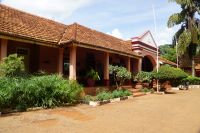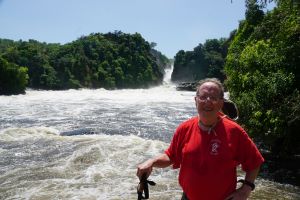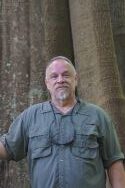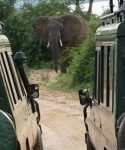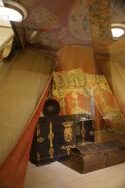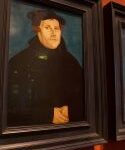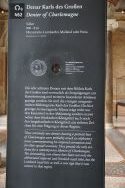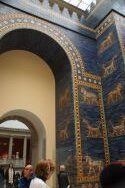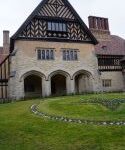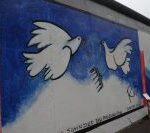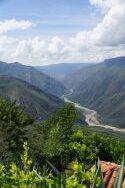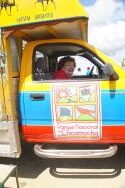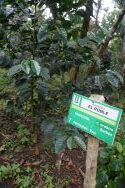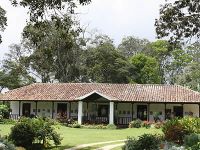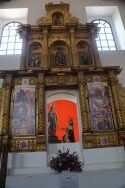May 17, 2018
As sometimes happens, our scheduled morning visit got canceled: the visit was to a coffee company, and since 72% of the employment (but 22% of the GDP comes from agriculture, and this what I thought would be our only agricultural visit, I was a little disappointed.
But, as I’ve said, you shouldn’t travel if you don’t have patience. And, since Patience is the name of our guide, we do have patience.
As well as a little free time. I’d wanted to go to the Uganda museum, partly because I’m a museum junkie. My record is 8 in one day, but before you say “wow,” I should, in honesty, note that that mark was set in Budapest, where the captions were in Magyar. There was no chance really of matching that here, but I did get to the museum.
I had a guide who explained most of the exhibits. At one extreme was a temporary exhibit about milk, jointly done between Switzerland and Uganda. I noted that living close to America’s dairy land, that exhibit was less interesting than many of the others.
The holdings were relatively sparse, I thought, but included some history of Uganda and the colonial divisions that traded German rights to Uganda for Heligoland (and a player to be named later?), and the subsequent border adjustments that created Uganda. These were done by the “colonial masters,” as the guide described them.
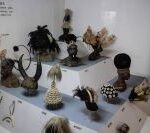 Perhaps most interesting to me were the artifacts from the Kabacka, the chief of the Burganda tribe, which was the most organized kingdom in what is now Uganda. There was a case with trappings of imperial splendor that were returned to Uganda from the British museum at independence. Another relic, the guide noted, was a copy of a sacred item that still rests in the British Museum. As is true of many areas (think the Elgin Marbles), after visiting a country, you have to go to the British Museum for the rest of the story. On the other hand, the tomb in town was vandalized and burned in 2010, and is currently (still) under restoration.
Perhaps most interesting to me were the artifacts from the Kabacka, the chief of the Burganda tribe, which was the most organized kingdom in what is now Uganda. There was a case with trappings of imperial splendor that were returned to Uganda from the British museum at independence. Another relic, the guide noted, was a copy of a sacred item that still rests in the British Museum. As is true of many areas (think the Elgin Marbles), after visiting a country, you have to go to the British Museum for the rest of the story. On the other hand, the tomb in town was vandalized and burned in 2010, and is currently (still) under restoration.
We’ve nonetheless had two wonderful days of activities: let me summarize some of what I’ve learned:
1) We had enough time to stop at a mall, and discovered where the middle (and upper) classes hang out. It could be in any town anywhere. There was a KFC, for example, and a major South African chain called Superrite, which claimed the lowest prices in Africa. Many of the coffee drinkers bought bags of Ugandan coffee, but they’re going home and don’t have to pack (like I do) for another leg of the journey. The most striking kiosk—one that screamed middle class (or better) was an opportunity to invest in Dubai, for $130,000. Divide by $750, the average national salary, to calculate how many years you would have to work to pay for it.
2) We went to a “cultural show” last night, that was without doubt the longest such event I’ve ever been to. It ranked right up there with Gotterdammerung, Wagner’s concluding saga in the Ring cycle. It started at 7 (we got there around 7:30), and was still going strong at 10:30. The dances were quite long, and the cast had incredible endurance. I saw some of the instruments I’d seen in the museum in use, as the format was to represent the 56 tribes (no wonder it went on for over 4 hours!). Good costuming and good choreography. See Mike Shealy’s facebook post if you want to sample it.
3) We had a visit to Stanbic Bank, Uganda’s largest. It’s originally a South African bank, and is headquartered in Johannesburg. The most interesting thing to me was that the largest shareholder is the Industrial and Commercial Bank of China (ICBC), which is a pattern we saw elsewhere. As he told us in the “War Room”—the sign over the conference room where we met—the Chinese come without conditions. Most of what he reported reinforced what we’d heard elsewhere: the demographics (a hope for the future of banking is a young population). Banks have 1.4 million customers, but there are 20 million cell phones in Uganda, which may explain the popularity of “mobile money.” He also stressed, for investors, the relative ease of doing business in Uganda, which has a Ministry of Investment. 100% foreign ownership is possible, and the shilling (this was a British colony, after all) is convertible into dollars.
4) We were able to put some of the pieces of the oil story together with a visit to Tullow Oil, the outcome of an Irishman’s dream with the help of a World Bank loan, becoming a niche player in African oil with a sub niche in exploration. The country was thought oil-poor until 2006 when Tullow discovered 1.7 billion barrels of commercially viable oil in the Lake Albert area. What followed was an interesting case study involving 3 companies, Tullow, Total (French), and CNOOC (Chinese), two governments (Uganda and Tanzania), social and environmental concerns (the oil is partly in Murchison Falls National Park), logistics (a 1450 km pipeline needs to be built to get the refined oil to a port. The pipeline needs to heat the oil to 50 celcius, and will be 6.5 feet underground); financing at $12-15 billion; and financial risk (though Tullow has an 90% success rate in Uganda in finding oil, the industry average is 25%), It has the makings of a great movie; I volunteered to be Indiana Jones.
5) Three of our visits, as it turned out, dealt in one form or another with agriculture, a sector which employs 72% of the country, and contributes 22% to Gross Domestic Product. Couple that with 30-40% spoilage from harvest to market, and you have the makings of a real challenge.
a) One of our visits was to a US government project, USAID, which in cooperation with UKAID, helps fund an organization that works with farmers in the poorer sections of Uganda. The director talked with us about the kind of successes she and her staff of 55 have had with the 7 year budget of $35 million dollars, $7 million of which is spent to help fund local projects. Working with, and sometimes through, local officials, RTI was able to muster 6,000 farmers to get the local community officials to build a new market, for example.
b) The second of our visits regarding agriculture was to a woman who has earned a variety of awards as woman entrepreneur of the year (Commonwealth 2014 was one), head of a company well named as Delight with branded juices under the Cheers label. Her personality reflected both; her work represented a social consciousness that was refreshing. Her goal was to help women become farmers by teaching them how to farm, lending them money to do so, buying their crops—initially for a tasty mango juice, no additives, and buying their products. At one time, she moved her operations to South Sudan, which has become a failed state ala Venezuela (a woman was 9x more likely to die in childbirth than graduate high school); she lost a lot of money as a result, but obviously has brought cheers to women in northern Uganda.
c) We visited Jankava, the company whose dried jackfruit snack will be featured next month on our Pictured Rocks backpack. Meg, the VP of American chamber of Commerce, who was our host, told us how she wound up in Uganda; a chance meeting with the Buganda queen. A chance meeting with Mr. Jakana led to her working for the trained- at-Texas El Paso Ugandan, who paid for college working in food processing and had started a food processing plant in Kampala. The company has moved from processing and selling fruits to processing and selling dehydrated natural fruits and juices to processing organic dehydrated fruits. She buys from certified organic farmers and wholesales products to retailers and wholesalers elsewhere. Part of her financing came from USAID, and part from crowdfunding. For those who read Machines, Platforms and Crowds, that source of funds will come as no surprise. The Kenyan government helped purchase a packaging machine, and the new equipment will double the capacity of the plant.
Well, it’s getting late, and I need to pack for my trip tomorrow to Kenya. I expected to visit the grave of Lord Baden Powell, the founder of Scouting, when I’m there, and I’ll be prepared, as a good Scout should be. I purchased at the Uganda Museum a special black stone that is supposed to be an antidote to snakebite. I hope I don’t have to use it, but if I do….
